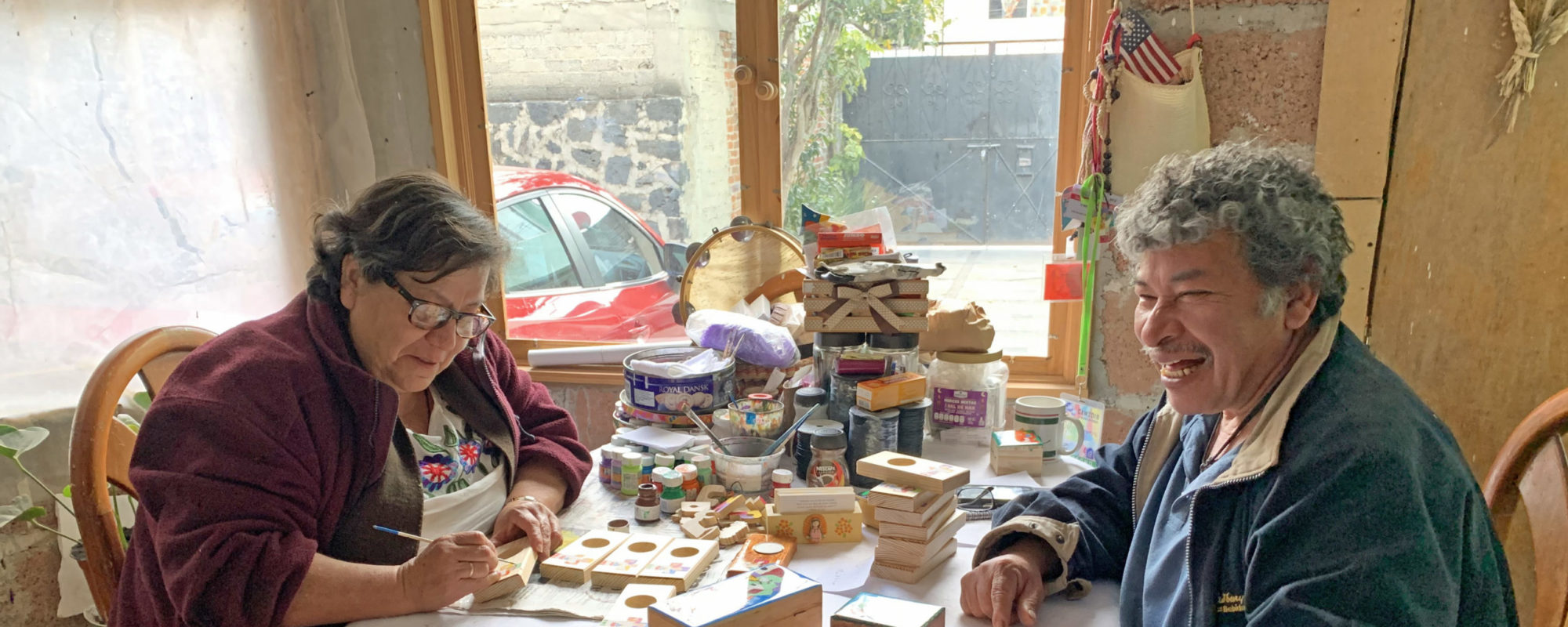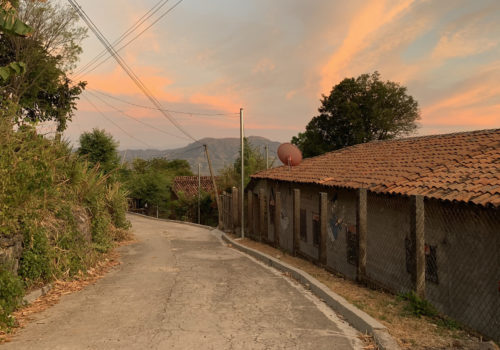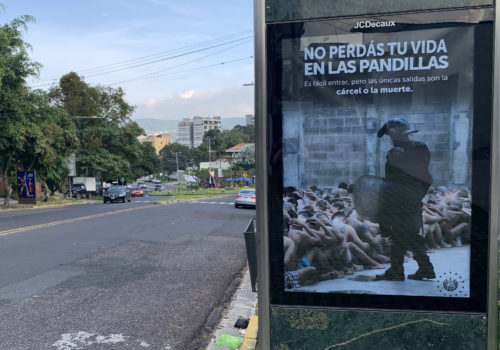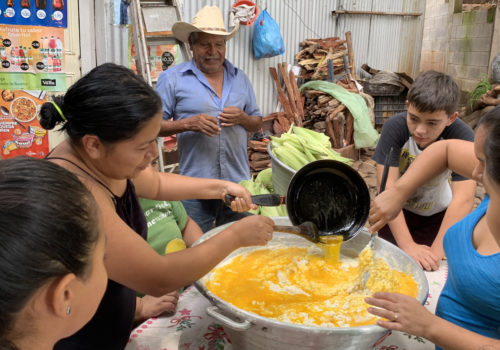MEXICO CITY — In an outer borough of the capital, Julio Lemus showed me around his cluttered studio. He demonstrated the table saw he uses to cut pieces of wood into crosses, letters and other shapes, which his wife Patricia paints in a traditional Salvadoran style invented by the artist Fernando Llort. Through their organization Colectivo Izalco (the “Izalco Collective,” named for a volcano in western El Salvador), the couple earns a meager living teaching about Salvadoran culture and selling their handicrafts at schools, art shows and festivals. Patricia, who is Mexican, has traveled to La Palma in northern El Salvador to learn the technique and shares her husband’s infectious enthusiasm about their work.
Julio has lived in Mexico City since 1985, when he fled violence from the Salvadoran civil war that took place from approximately 1980 until 1992. By 1990, some 500,000 Salvadorans were living in Mexico, according to the historian María Cristina García. Now, there are thought to be fewer than 10,000.
I hoped Julio would help me understand the historical context of Salvadoran migration to Mexico and shed light on the possibilities for recent asylum-seekers like Gabriel, a young man I profiled on a previous trip. Since July of last year, the US government now requires asylum-seekers who arrive at the southern border to first apply for asylum in Mexico or Guatemala, and other restrictions have made it much more difficult for Central Americans to enter the United States.
Mexico’s new left-wing president Andrés Manuel Lopez Obrador (known as AMLO) had been expected to pursue a more open immigration policy, but instead has continued building up the militarization of the country’s southern border. During my visit, the National Guard violently broke up a new “caravan” of mostly Hondurans traveling together.
Still, Mexico provides for a more generous definition of “refugee” than the US law, and the number of applications has increased exponentially over the last few years. As immigration to the US becomes more difficult, could the country again become a major destination for Salvadoran migrants?
“Migration is like another birth”
When Julio arrived in Mexico City in 1985, he held a 90-day visitor visa and had made no plans beyond that time. “I wasn’t thinking about the future, I just needed a place where I could breathe,” he said. “I was afraid of ending up in El Playón,” a lava field on the San Salvador volcano that served as an infamous body dump during the war.
As a child in rural western El Salvador, he had dreamed of seeing the world, and first visited Mexico as a teenager. (He was turned away the first time he tried to cross the border because he didn’t have a passport. After getting the proper paperwork—which was relatively easy at the time—he came back for a visit but never considered a longer stay.)
A few days after Julio’s arrival in 1985, a catastrophic earthquake struck Mexico City. He soon met Patricia, who as a young woman got permission from her parents to help in the relief efforts. (In an example of Mexico’s deep history of immigration, Patricia’s father had once been a migrant worker in the United States.) The young couple moved in together the following year and had two children but were unable to marry because of Julio’s lack of immigration status.
He never received asylum. It took him until just a few years ago, almost 30 years after he had arrived, to finally obtain permanent residency through his wife. For reasons he can’t articulate, he was not accepted by the United Nations High Commission for Refugees (ACNUR, in its Spanish acronym). Instead, he remained undocumented throughout the war, supporting himself by selling handmade crafts and practicing natural medicine. (He studied naturopathy partly with the hope that he could return to El Salvador and bring the new knowledge with him.)
Despite the hardships of the war years, both Julio and Patricia look back fondly on his time in exile, which they remember as one of solidarity. In the era before cell phones, Salvadorans found one another through their personal networks or gathering at one of many organizations providing aid to migrants. Julio remembers being given cash handouts and food provisions by enthusiastic volunteers.
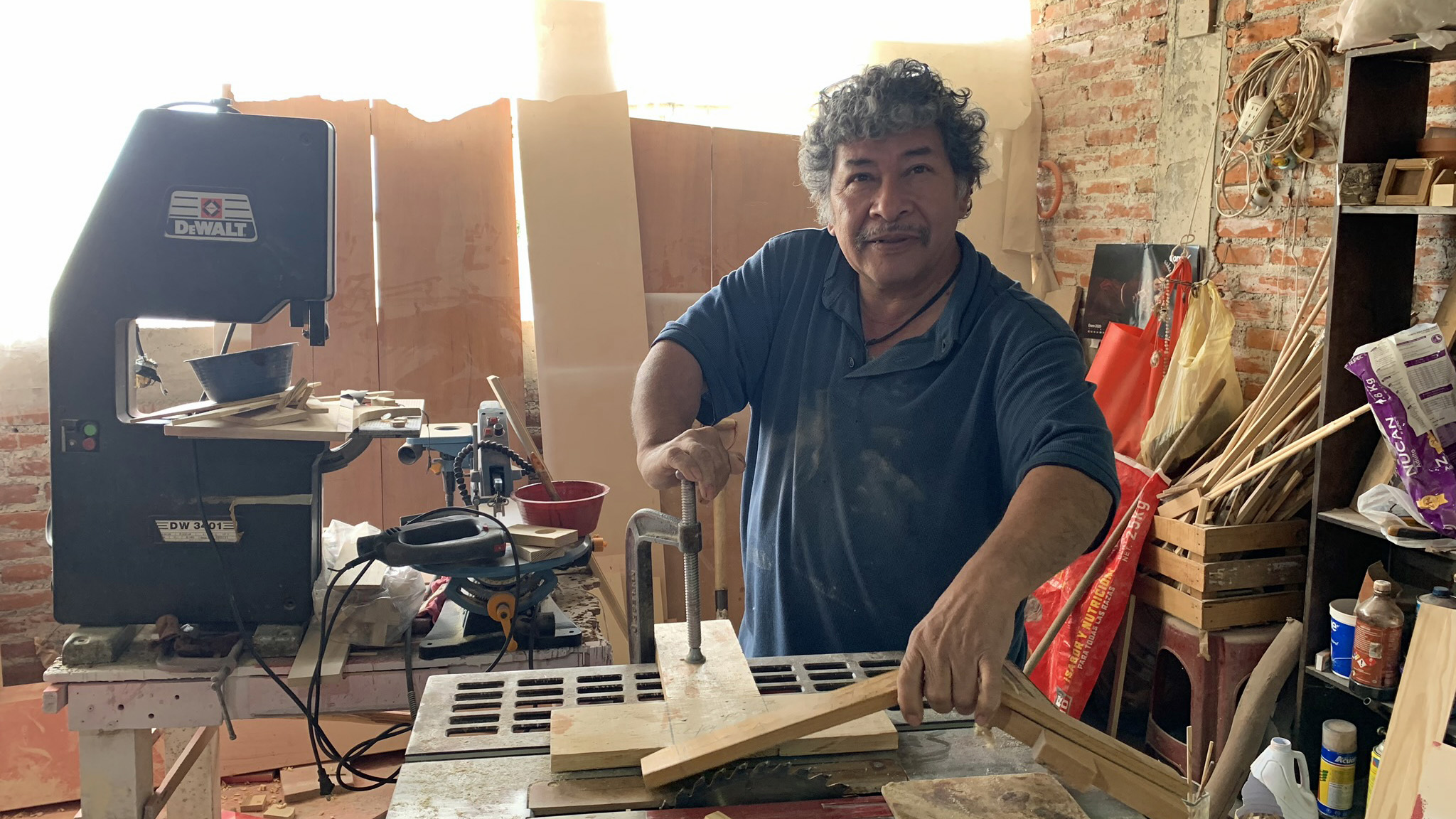
At that time, most migrants were young, single men, and several of them came to live with Julio and Patricia for months at a time, then kept in touch after they moved on. Julio reflected on exile, saying “When we are born, we have family, security, a country. Migration is like another birth, you’re like a baby again, but without all those things.” Patricia said she had been glad to provide for the young men who passed through their home.
The Salvadoran civil war ended with a negotiated peace agreement signed in 1992 at Mexico City’s Chapultepec Castle. With the peace accords, the Salvadoran exile community scattered. Some went back to El Salvador, while others moved on to the United States or Canada. Others who had taken up residence in Mexico under false Mexican identities continued to do so.
Julio had planned to go back, but now that he had Patricia and their children, his priorities had changed. He felt disconnected from Salvadoran life and had doubts about whether the country would really be safer despite the negotiated peace. Indeed, politically motivated killings continued into the 1990s and the homicide rate increased.
Julio briefly returned to El Salvador to get necessary paperwork and reentered Mexico on a visa that allowed him to go only as far north as Cuernavaca, about an hour south of Mexico City. He and Patricia were finally married in 1993, and he continued renewing his temporary status for over twenty years before being granted permanent residence. Sometimes the family could not afford to pay his legal fees and his status lapsed.
Now Julio and Patricia would like to create a space where the remaining Salvadorans can gather and preserve their culture in Mexico City. But although more and more Salvadoran migrants are coming here, relationships among them aren’t the same. The new arrivals are less trusting, more suspicious. Instead of young single men, recent migrants tend to be families with women and children with a complicated constellation of needs. People seem determined to make it to the United States, and to rely on their own networks as much as possible. They are less likely to look for and receive help.
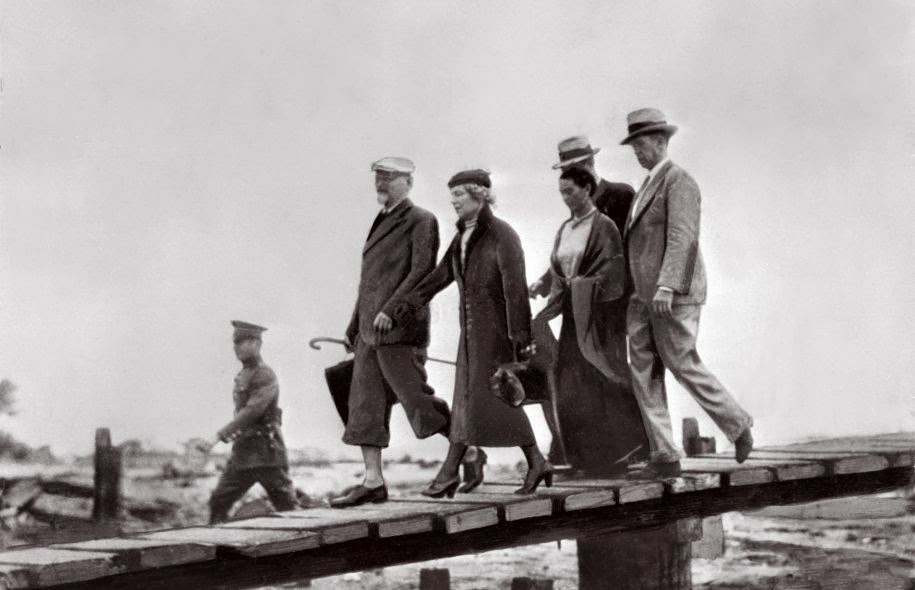
Mexico’s changing identity as a destination country
Mexico has long prided itself on its identity as a welcoming country to refugees from around the world: famous exiles have included Leon Trotsky, Leonora Carrington, Pablo Neruda and, most recently, Evo Morales, the deposed president of Bolivia. Yet there was no codified procedure for applying for asylum, and the word “refugee” did not appear in Mexican law until 1990. Mexico did not become a signatory to the United Nations Convention and Protocol Relating to the Status of Refugees until 2000.
The Mexico Refugee Assistance Commission (COMAR) was created in 1980 as a response to an influx of Central Americans fleeing civil war. (In 1979, Sandinista rebels overthrew the US-backed Somoza family that had ruled Nicaragua for more than four decades. Guatemala had been in conflict since a 1954 US-sponsored coup overthrowing the democratically elected Jacobo Arbenz, and violent repression against indigenous communities reached its peak in the early 1980s.)
Trotsky was granted temporary refuge in Turkey, France and then Norway after his exile from the Soviet Union in 1929. However, none provided a lasting home; they either forced him to stop writing and withdraw from public life or their changing political situations made them unstable. He arrived on an oil tanker to Mexico in 1937 and was welcomed by then-President Lázaro Cárdenas. For a little over two years, he lived with the artists Frida Kahlo and Diego Rivera in the bohemian Coyoacán neighborhood, then moved into a home of his own just a few blocks away. He was assassinated in August 1940 and his former home is now a museum that also houses an organization called the Institute of the Right to Asylum.
When I dropped by to visit and ask about its work, I was introduced to the director, Gabriela Pérez Noriega. At a conference table in the institute’s library, she declined to provide details about the institute’s work for safety reasons. But she spoke vehemently against the caravans. At first, I wasn’t sure I was understanding her correctly as she told me they were made up of “elements” paid by the United States to destabilize Mexico and threaten its national sovereignty. Asylum applications from Central Americans had to be carefully vetted for security reasons, she said—a surprising position for an organization ostensibly dedicated to preserving the right to asylum. As I spent more time in Mexico, I learned that that has become a widely held view.
Even Alejandro Solalinde, a Catholic priest who became famous as a fearless defender of migrants and the founder of a migrant shelter in southern Oaxaca, has changed his position. In November, he gave an inflammatory interview to the digital newspaper El Faro. It was mentioned by multiple people I spoke to in Mexico, who expressed their shock and dismay at what they saw as a betrayal of Solalinde’s values.
Migrants have been viewed with increasing suspicion in Mexico, particularly the caravans, beginning in 2018. A widely held position, even among the defenders of migrant rights, is that many Central Americans are no longer fleeing violence and poverty but being sent to destabilize the Mexican government.
In it, he expressed his unwavering support for AMLO, citing YouTube videos he claimed proved that the migrants now traveling through Mexico from Central America, particularly the caravans beginning in 2018, are no longer fleeing violence and poverty but being sent to destabilize the AMLO government. The rights of migrants had to be sacrificed in order to support the new government, he said: “the priority is Mexico.”
At a meeting with various immigrant rights organizations at a house owned by the University of California not far from the Trotsky museum, Elizabeth Lara from the National Human Rights Commission (CNDH) spoke frankly about the challenges faced by those advocating for immigrant rights. “This government’s immigration policy is completely incongruous,” she said. “It lacks a human face.” Pledging to help immigrants, she bemoaned the lack of resources dedicated to COMAR and migrant shelters and other services. Bernardo Méndez Lugo, a former diplomat and current executive director of América Sin Muros (“America Without Walls”), praised her honesty and principled stand. But Lara’s views appear to be unpopular in the current administration.
Delayed paperwork reveals precarity of life in Mexico
On my previous visit to Mexico in August, I met a young Salvadoran man I called Gabriel who was waiting for a decision on his asylum application. I wanted to see him again and find out how things were going, but he did not respond to my messages via WhatsApp. When I saw that he had not been online for over two months, I contacted his mother in San Salvador, who helped me connect with Gabriel via Facebook.
During our first meeting, he had been optimistic and excited about his new life in Mexico. He was sharing an apartment with friends and working as a cook in a hotel in the upscale Reforma neighborhood, not far from the US Embassy. In the space of a few months, his luck had changed. A procedural delay in the renewal of his work authorization caused him to lose his job, although his manager said he would hire him back once the paperwork came through.
Since losing his status, Gabriel had tried to find other employment to support himself and contribute to household expenses. A construction project took him away from home for three nights; at the end of it, he was paid less than half of what had been promised. He recently took a grueling and dangerous job as an unarmed security guard at a bus terminal, working 24-hour shifts every other day.
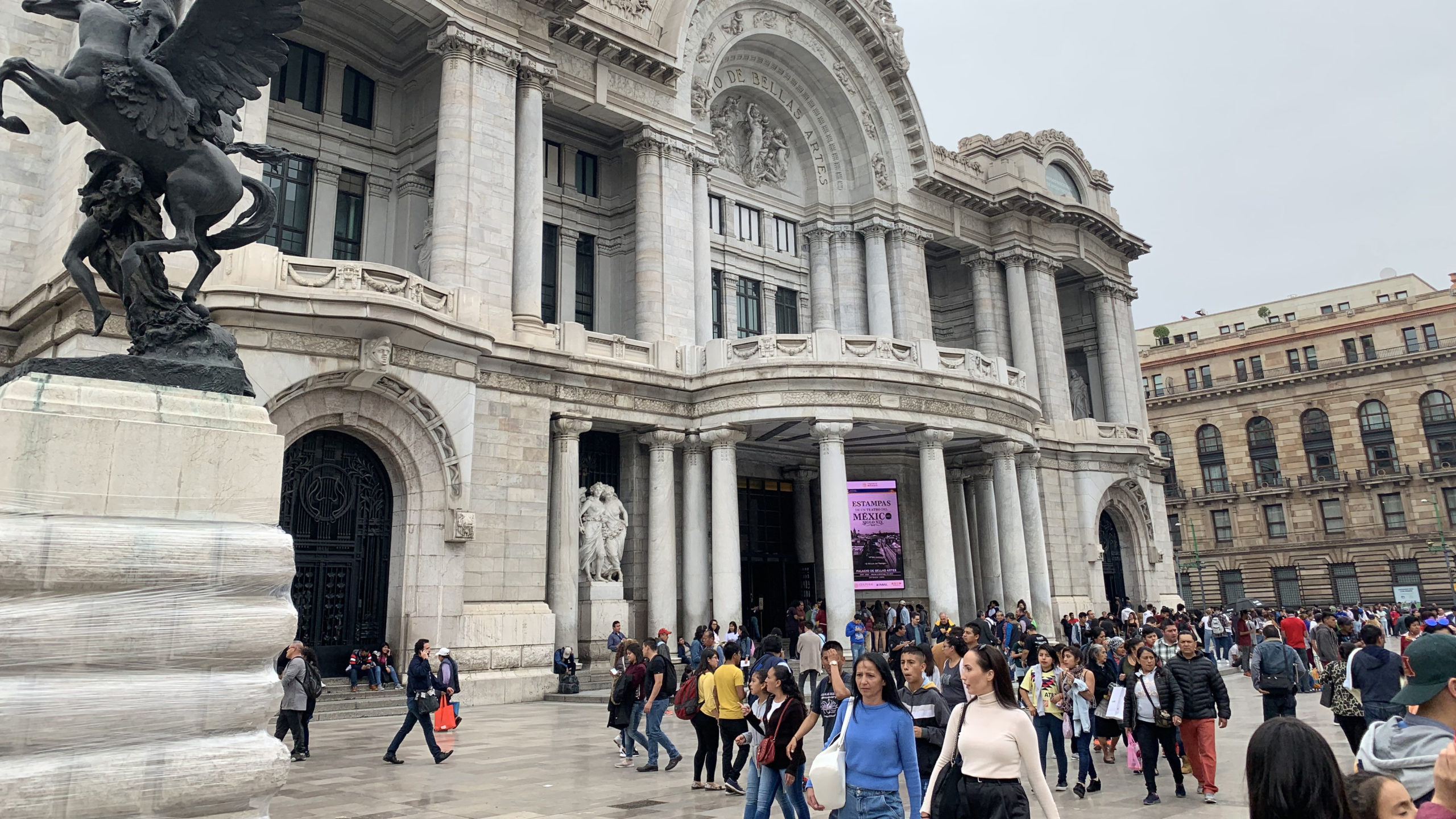
Unable to pay the rent, he soon lost his housing. He had recently started dating a Salvadoran girl whom he had met while visiting friends at a migrant shelter, and her family agreed to take him in. (I’ll call her Esperanza.) Without their support, he would surely have become homeless.
Esperanza’s family left the migrant shelter and moved to nearby Chimalhuacán, a city of over 600,000 in Mexico State. Chimalhuacán is a notoriously unstable and dangerous place: The first weekend of my visit, people took to the streets to march against femicide because of the high number of killed and disappeared women (a government warning about rampant violence against women there is currently in effect). Among the city’s notorious past residents was a spree killer called “The Decapitator of Chimalhuacán.” The governing Antorchista Movement has taken up arms to preserve its power as recently as the year 2000. When I told friends I was considering going there to see where Gabriel lived, they strenuously warned me against it. Everyone else I spoke to said the same, and Gabriel suggested we meet in a tourist area that would be safer. He told me he and Esperanza’s family tried to keep a low profile.
Soon after the family arrived, Gabriel was mugged and his phone stolen—the reason I couldn’t contact him. I asked if he had thought about returning to El Salvador given the dangers and hardships he has been facing in Mexico (and his professed nostalgia for his home country). He shook his head: He still feels safer in Mexico. The street where he lives has a thriving drug trade and he has witnessed police officers interacting with drug dealers, presumably accepting bribes. But at least they don’t bother him, he said. Here in Mexico, he feels free to wear the clothes he wants and travel to different neighborhoods. Although he originally fled El Salvador because of gang violence, when he talks about his fear of returning, he focuses on the police. There has been an increased law enforcement presence in his neighborhood since President Bukele took office. Instead of feeling safer, he worries about being profiled as a possible gang member.
Hope amid the hardships
Although he was interviewed about his asylum application in early January, Gabriel told me he was again considering an attempt to reach the United States. After almost a year in Mexico, Esperanza’s family members face the expiration of their humanitarian visas later this spring. They are considering moving on and presenting themselves at the US border while they are still legally authorized to travel in Mexico.
It has taken Gabriel time to adjust to living as part of a family. Even in El Salvador, he had felt alone. His mother was always working, and he and his older brother weren’t particularly close. He dropped out of school to begin working at a young age and was used to figuring things out for himself. Esperanza’s family is different: when one has a problem, they all sit down and talk it through together. Tears come to Gabriel’s eyes when he describes how alone in the world he previously felt.
A few days after I left, he sent me a Facebook message saying his asylum application had been approved. It was the “best” kind, he told me: an asylum status that leads to permanent residence, not the “complementary protection” that offers fewer benefits. He was excited to get back to work at the hotel.
Despite the positive development, Gabriel’s future remains uncertain. If Esperanza’s family is not granted asylum—or it decides not to wait for a decision but to try its luck in the US—Gabriel will have to choose between staying alone in Mexico City or taking another dangerous journey.
With Mexico’s climate increasingly hostile to Central Americans and few strong family networks in the Salvadoran exile community, it’s not surprising many Salvadorans do not see Mexico as a long-term destination.

